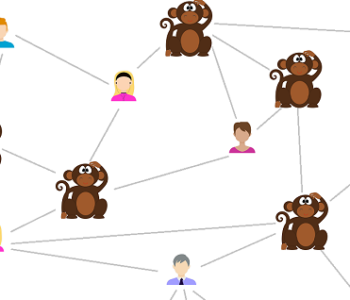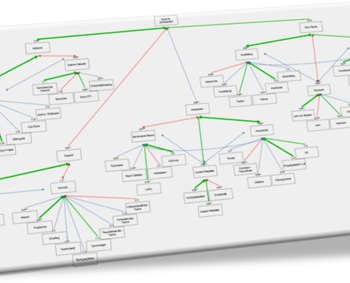
Organic growth and the Semantic Network of a website
Organic growth reflects how well a webpage covers its SEO Space, which in turn depends on the quality of the Semantic Network. The Semantic Network is a graphic representation of the search concepts associated with the SEO Space of a website. For their website, every brand team needs a Semantic Network in line with the brand strategies.
Organic growth, modern SEO, and the Semantic Network
The Semantic Network displays, succinctly, the topics intended to attract visitors and create website traffic.
The SEO Story describes how to leverage the Semantic Network themes and win the attention of both people and search engines, so to create organic growth.
For instance, an insurance company wishing to attract visitors interested in Auto, Travel, Fire, and Life insurance may draw a Semantic Network as in the following image.
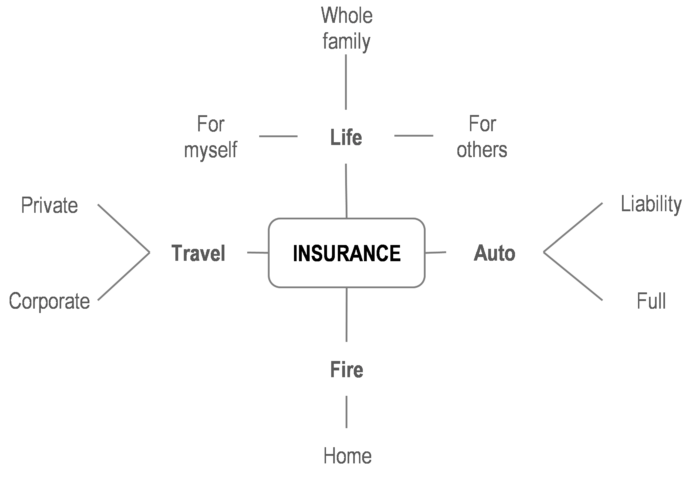
Image 1: Semantic Network of an insurance company.
The seed concept in the middle sets the route.
The first node of a branch, a sub-topic, Travel for instance, defines a major area of search engine queries.
Sub-topics past the first level define major themes, in order to cover all relevant facets of an SEO theme, such as Private and Corporate travel.
The whole network, as well as each branch and its nodes, is measurable in terms of search volume and of difficulty to beat competing pages aiming to attract the same audience we are after.
Semantic Networks foster strategic thinking and organic growth
Semantic Networks help reduce the guess-work behind website optimization and are a useful exercise to foster strategic thinking and boost organic growth.
Not only do Semantic Networks help in thinking about the SEO project in strategic terms, they also help us think strategically about the brand or business because advanced SEO techniques connect the website role to the brand strategic plan.
The Marketing Strategy, the Copy Strategy, and the Media Strategy of a brand are key in determining the job the website is supposed to do for the brand. Instead of the website being just the package of a product, it becomes part of the product technical performance (hence of the Product Strategy) and a source of incremental business.
I strongly encourage you to read this on the strategic architecture of a brand as it is understood by marketing champions at multinational companies.
Numbers show the SEO route
The measurability of the elements of Semantic Networks is critical when selecting an SEO Space with the potential for attracting significant numbers of website visitors.
Imagine a fragmented SEO Space. Imagine a long list of rarely searched search engine queries, such as in the insurance industry, for example. How can one reasonably optimize a website in such cases?
It is difficult, which is why many insurance company websites do not deliver according to expectations, especially for Sales staff.
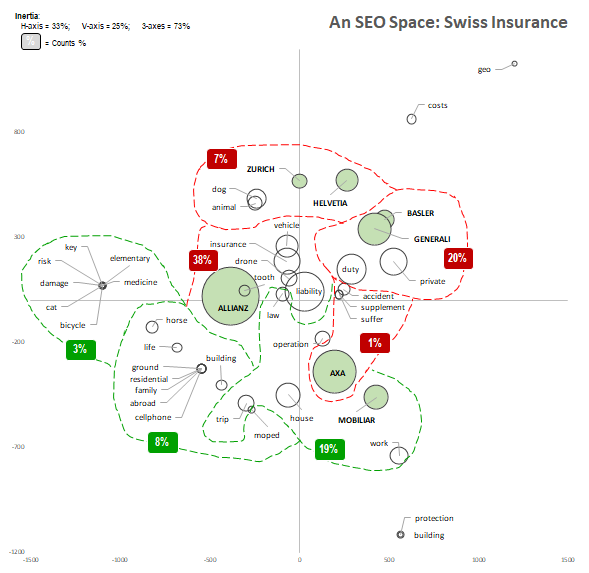
The SEO Space of the Swiss insurance industry
The SEO Space of the insurance industry is rather flat, quite fragmented, and in large part driven by company names.
In Switzerland, almost 50% of search strings related to the word Versicherung, German for insurance, include an insurance company name. For instance, “visana zusatzversicherung”, “axa autoversicherung”, or “smile direct versicherung», just to name a few.
Reading such cases from a strategic standpoint, it seems reasonable to not focus on the technical performance of the products (what to insure), but instead to ascend the need pyramid and link the brand to an impulsive need (why insure).
Like the candies at the supermarket counter, the emotional need arises when I see them. Similarly, when I take a risk the need for insurance may arise. For instance, when organizing a trip, considering buying a car, planning a fireworks display, or moving house. These are the times when people think about risk and insurance. If the team is smart enough to offer products of true value, website traffic will come.
How to cover the SEO Space and create organic growth
The SEO Space describes the search space where comparable web pages compete to increase website traffic and find organic growth.
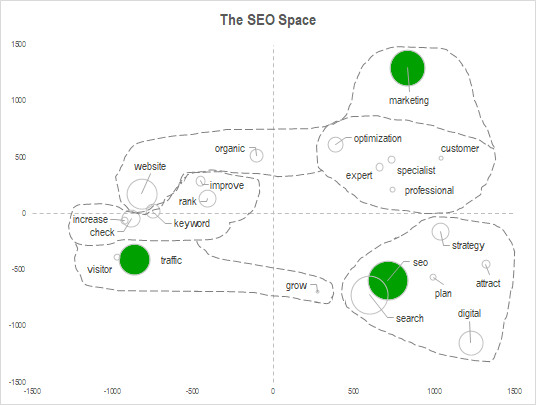
The SEO Space is the comprehensive collection of relevant search topics that you aim to associate your webpage with, to climb the search engine ranking lists.
Assigning priorities is paramount. Deciding how much weight to assign to each topic of the Semantic Network is extremely important because it suggests the quantity of text content and the depth of the content to be employed.
Topic, Content, Depth, and Density are the measures we look to when optimizing online content and seeking organic growth.
In general, networks that are too deep may result in areas of insufficient search volume, while networks that are too flat may require an overwhelming quantity of content in order to ramp up the SERP results.
MarketingStat has perfected its approach to SEO and found that a balanced approach works well to create organic growth. In certain cases, going deeper than Seed Topic, Sub-topics, and one- to two-node declinations of sub-topics may lead to a dead zone.
The Semantic Networks of the insurance industry
Of course, there are always exceptions. The insurance industry is one of these: its Semantic Networks tend to stay rather flat because the search queries are rather fragmented and small in volume.
So in this industry, expecting traditional SEO activities to result in a substantial increase in website traffic and organic growth may prove disappointing.
Insurance marketers must move up the need pyramid and emphasize emotional over functional reactions; focusing on reducing anxiety, for example, will get better results than, say, saving time, money, effort, and the like.
Anxiety grows in new and unknown situations as well as when the stakes are high.
Smart insurance companies that reorient their SEO efforts may benefit from an increased number of visitors and, more importantly, from an injection of fresh thinking that uncovers new target groups as well as innovative products.
How to create Semantic Networks
The elements of a Semantic Network are added in a radiant way. MarketingStat’s experience suggests starting from the central seed word and expanding the network concentrically, one topic level at the time.
The hierarchical order of themes in a network is important. For instance:

Image 2: Hierarchical order of search words.
In SEO terms, “machine” is a more powerful word than “ford”, because it relates to a broader range of subordinate topics. Although, the more power a word has, the more difficult to establish authority over it.
The seed word is the central element to shape and expand the process of associating search topics in a Semantic Network.
Related themes radiate from the center of the network like branches of a tree.
Branches are lateral extensions of the seed theme. They cover a single, unique, and meaningful space of related search strings. Therefore, branches could stand by themselves and form a separate Semantic Network.
Semantic Networks useful for SEO have enough search engine queries
The exact amount of the required search volume depends on the brand ambitions and investment plans.
Rules & Laws of Semantic Networks
- The brand or business inspires the seed concept.
- Create the network with the semantic meaning of words in mind. Common words are searched more frequently than uncommon words.
- Expand the network based on the person’s needs concerning the seed topic.
- Expand the network hierarchically.
- Validate each network branch also with the frequency of search volume and the level of competitiveness.
- Be precise. Use only one or two words to describe a topic. The more words, the lower the power of attraction.
- The farther a topic (node) lies from the seed topic, the weaker its search attraction power.
- When a network gets large, split it and optimize each part separately.
- When unsure ask the customer (market research).
- Give answers. Search questions are inspiring elements.
- Be objective, listen to the gut, and make hypotheses. After all, you are a search engine user too.
- Being creative is not always a good thing when creating Semantic Networks. Try to think like the majority of people in your network.
These theme categories are often useful to build a Semantic Network:
- Question forms: What, when, where, who, why, which, how.
- Properties or characteristics of themes, like names of things and person categories.
- Functions: What things do.
- Process: How things work.
- Classification: Order of magnitude, better versus worse, and in general how things relate to each other.
- Definitions: The meaning of things.
- Role: How to influence people and things (e.g., expert, consultant, guru).
Thinking of SEO and websites from a new, strategy-driven standpoint is rewarding for the business and, more than anything, it is fun to do!
MarketingStat would be pleased to accompany you into the fascinating world of modern SEO.
